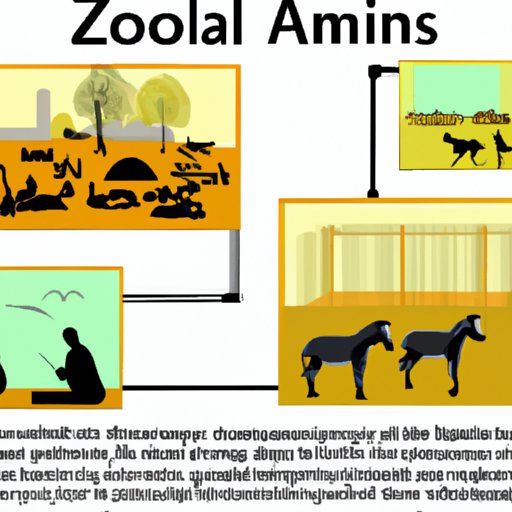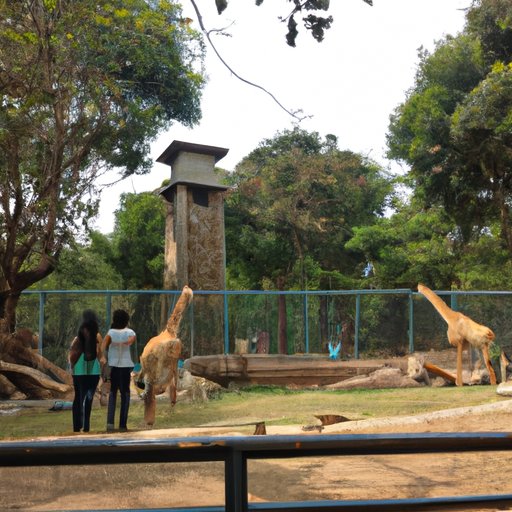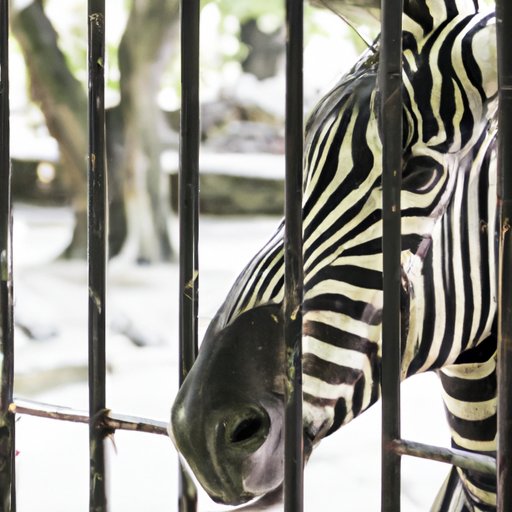Introduction
A zoo is defined as a facility in which animals are kept in enclosures and displayed to the public for educational or entertainment purposes. While the concept of keeping wild animals in captivity has existed since ancient times, the modern-day zoo is a relatively recent invention. This article will explore the history of zoos and the impact they have had on society, including examining the early origins of zoos, exploring the first publicly accessible zoos, analyzing the impact of zoos on society, and evaluating the benefits and drawbacks of keeping animals in zoos.

Historical Overview of the Invention and Development of Zoos
Examining the Early Origins of Zoos
The practice of keeping animals in captivity dates back to ancient times. The earliest known example of this was in 3500 BC in Egypt, where Pharaohs kept exotic animals such as lions, crocodiles, and hippopotamuses as symbols of power and prestige. This practice spread throughout the Middle East and Europe in subsequent centuries, with courts and rulers displaying exotic animals in their menageries as a sign of wealth and status.
Exploring the First Publicly Accessible Zoos
The first publicly accessible zoos can be traced back to the 18th century. The first recorded zoo was opened in 1752 by the Empress Maria Theresa of Austria at the Schönbrunn Palace in Vienna. This collection of animals was initially for royal entertainment, but it eventually became open to the public in 1765. The oldest surviving zoo in the world today is the Tiergarten Schönbrunn, which was established in 1779. Other early examples of public zoos include the Jardin des Plantes in Paris (1793), the London Zoo (1828) and the Central Park Zoo in New York City (1864).
Analyzing the Impact of Zoos on Society
Comparing Ancient and Modern Zoos
Zoos have changed significantly since their inception in the 18th century. In the past, zoos were often viewed as a form of entertainment, with little attention paid to animal welfare or conservation. Today, however, zoos are increasingly seen as important educational and conservation institutions. According to a study conducted by the World Association of Zoos and Aquariums, modern zoos “contribute to global biodiversity conservation strategies and promote public understanding of wildlife and ecosystems”.
Investigating the Role of Zoos in Conservation Efforts
The role of zoos in conservation efforts is increasingly being recognized. Zoos are involved in a range of activities, from research and education to captive breeding programs for endangered species. For example, zoos have been instrumental in the successful reintroduction of many species, such as the California condor, the black-footed ferret, and the Arabian oryx. Zoos also play an important role in public awareness and understanding of conservation issues, reaching millions of people each year.

Evaluating the Benefits and Drawbacks of Keeping Animals in Zoos
Advantages of Zoos
There are several advantages to keeping animals in zoos. Firstly, zoos provide animals with a safe, protected environment, free from predators and other threats. Secondly, they offer a unique opportunity to educate the public about wildlife and conservation. Finally, zoos are also involved in important research and breeding programs for endangered species, helping to ensure their long-term survival.
Disadvantages of Zoos
However, there are also some drawbacks to keeping animals in zoos. Animals in captivity are often deprived of their natural habitat and social interactions, leading to physical and psychological distress. Furthermore, zoos may not always be able to provide animals with adequate space and enrichment activities, resulting in boredom and frustration. Finally, there is also the risk of animal escapes and attacks on visitors.
Conclusion
In conclusion, zoos have come a long way since their invention in the 18th century. They have evolved from mere entertainment attractions to important educational and conservation institutions. While there are many benefits to keeping animals in zoos, there are also some drawbacks that need to be taken into consideration. Ultimately, it is up to individuals to decide whether or not zoos are beneficial for animals and society as a whole.
Summary of the Article
This article explored the history of zoos and the impact they have had on society. It examined the early origins of zoos, explored the first publicly accessible zoos, analyzed the impact of zoos on society, and evaluated the benefits and drawbacks of keeping animals in zoos. Overall, it concluded that while zoos offer many advantages, there are also some drawbacks that need to be taken into consideration.
(Note: Is this article not meeting your expectations? Do you have knowledge or insights to share? Unlock new opportunities and expand your reach by joining our authors team. Click Registration to join us and share your expertise with our readers.)
